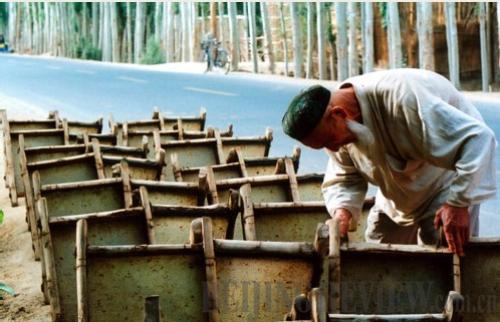|
 |
|
MULBERRY BARK PAPERMAKING: Pulp is mixed and stirred after the bark is peeled, soaked and boiled (GUANGMING DAILY) |
"Six generations of my family have been making mulberry bark paper," said Obulkasim, an artisan from Buda Village in Moyu County, Hotan Prefecture in northwest China's Xinjiang Uygur Autonomous Region.
Obulkasim said the handicraft has been handed down from his ancestors. As a youngster, he used to see his father and grandfather making paper whenever he returned home from school. When his father was too old to continue, he naturally took over duties.
Since ancient times, the Uygur people in southern and eastern parts of Xinjiang have lived in compact communities and harvested mulberries. During the Tang Dynasty (618-907), locals started using the bark of tender mulberry branches to make paper.
Obulkasim said the inner skin of the bark is glutinous and its fiber fine and smooth, hence it is easy to process. The bark is peeled, soaked, boiled, beaten, fermented, filtrated, molded and dried before being made into paper. The finished product is graded as high, medium, or low, according to quality.
Mulberry bark paper made is strong and tenacious, and can easily absorb water. It can last more than a thousand years without fading if painted with good ink, Obulkasim said.
Unfortunately, Obulkasim's family is no longer making the paper, since there is no market for it and youngsters are not willing to do it. Moreover, the handiwork takes a long time while producing limited amounts of paper.
For these reasons, mulberry bark paper disappeared from the Uygur scene during the 1980s and faced the danger of becoming extinct, according to Obulkasim.
 |
|
DRYING PROCESS: The bark is peeled, soaked, boiled, beaten, fermented, filtrated, molded and dried before being made into paper (FOLKW.COM) |
Rebirth of time-honored tradition
After mulberry bark paper was specially selected and used to renovate old paintings at the renowned Palace Museum in Beijing, it again caught public attention and was listed as a State Intangible Cultural Heritage on May 20, 2006.
This brought about new opportunities for the rescue and renewal of the unique papermaking skill. If, however, the paper becomes a general-purpose commodity, it would lose its cultural protection status.
In order to raise awareness of this special cultural heritage, the Region's Department of Culture held a photography exhibition in Urumqi, capital of Xinjiang Uygur Autonomous Region, on June 19, 2006, with all 160 photographs printed on mulberry bark paper. At the end of the year, the show also traveled to the Republic of Korea upon invitation.
A traditional painting exhibit was staged at the Region's Library at the end of 2011. For the first time, more than 100 traditional Chinese painters across the country painted on mulberry bark paper, to rave reviews.
In addition, the exhibit titled Indigo Foil: Traditional Chinese Painting on Mulberry Bark Paper was shown in China's 19 provinces and municipalities including Beijing, Shanghai, Hebei and Jiangsu between March and May last year, catching great interest from audience.
Having obtained such good results, people from Xinjiang Uygur Autonomous Region have managed to revive mulberry bark paper production, perfectly combining traditional skills with modern cultural elements.
(Source: Guangming Daily) |
